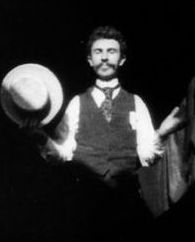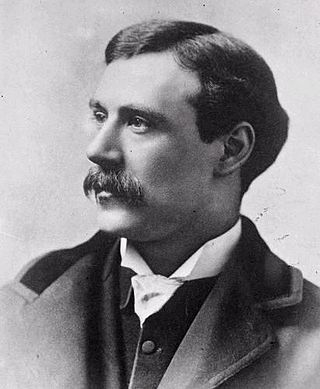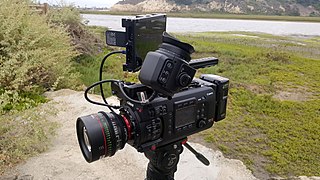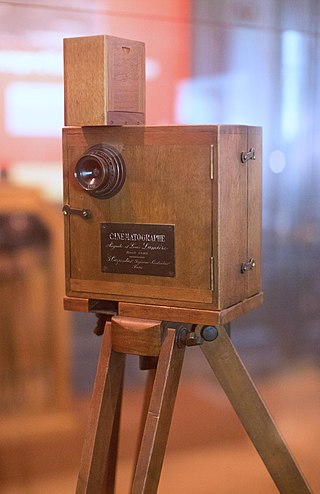
The Lumière brothers, Auguste Marie Louis Nicolas Lumière and Louis Jean Lumière, were French manufacturers of photography equipment, best known for their Cinématographe motion picture system and the short films they produced between 1895 and 1905, which places them among the earliest filmmakers.

William Kennedy Laurie Dickson was a British inventor who devised an early motion picture camera under the employment of Thomas Edison.

35 mm film is a film gauge used in filmmaking, and the film standard. In motion pictures that record on film, 35 mm is the most commonly used gauge. The name of the gauge is not a direct measurement, and refers to the nominal width of the 35 mm format photographic film, which consists of strips 1.377 ± 0.001 inches (34.976 ± 0.025 mm) wide. The standard image exposure length on 35 mm for movies is four perforations per frame along both edges, which results in 16 frames per foot of film.

William Friese-Greene was a prolific English inventor and professional photographer. He was known as a pioneer in the field of motion pictures, having devised a series of cameras in 1888–1891 and shot moving pictures with them in London. He went on to patent an early two-colour filming process in 1905. Wealth came with inventions in printing, including photo-typesetting and a method of printing without ink, and from a chain of photographic studios. However, he spent it all on inventing, went bankrupt three times, was jailed once, and died in poverty.
The following is an overview of the events of 1895 in film, including a list of films released and notable births.

A movie camera is a type of photographic camera that rapidly takes a sequence of photographs, either onto film stock or an image sensor, in order to produce a moving image to display on a screen. In contrast to the still camera, which captures a single image at a time, the movie camera takes a series of images by way of an intermittent mechanism or by electronic means; each image is a frame of film or video. The frames are projected through a movie projector or a video projector at a specific frame rate to show the moving picture. When projected at a high enough frame rate, the persistence of vision allows the eyes and brain of the viewer to merge the separate frames into a continuous moving picture.

The Kinetoscope is an early motion picture exhibition device, designed for films to be viewed by one person at a time through a peephole viewer window. The Kinetoscope was not a movie projector, but it introduced the basic approach that would become the standard for all cinematic projection before the advent of video: it created the illusion of movement by conveying a strip of perforated film bearing sequential images over a light source with a high-speed shutter. First described in conceptual terms by U.S. inventor Thomas Edison in 1888, it was largely developed by his employee William Kennedy Laurie Dickson between 1889 and 1892. Dickson and his team at the Edison lab in New Jersey also devised the Kinetograph, an innovative motion picture camera with rapid intermittent, or stop-and-go, film movement, to photograph movies for in-house experiments and, eventually, commercial Kinetoscope presentations.

A movie projector is an opto-mechanical device for displaying motion picture film by projecting it onto a screen. Most of the optical and mechanical elements, except for the illumination and sound devices, are present in movie cameras. Modern movie projectors are specially built video projectors.
Thomas J. Armat was an American mechanic and inventor, a pioneer of cinema best known through the co-invention of the Edison Vitascope.

Cinematograph or kinematograph is an early term for several types of motion picture film mechanisms. The name was used for movie cameras as well as film projectors, or for complete systems that also provided means to print films.

Major Woodville Latham (1837–1911) was an ordnance officer of the Confederacy during the American Civil War and professor of chemistry at West Virginia University. He was significant in the development of early film technology.
Eugène Augustin Lauste was a French inventor instrumental in the technological development of the history of cinema.

Vitascope was an early film projector first demonstrated in 1895 by Charles Francis Jenkins and Thomas Armat. They had made modifications to Jenkins' patented Phantoscope, which cast images via film and electric light onto a wall or screen. The Vitascope is a large electrically-powered projector that uses light to cast images. The images being cast are originally taken by a kinetoscope mechanism onto gelatin film. Using an intermittent mechanism, the film negatives produced up to fifty frames per second. The shutter opens and closes to reveal new images. This device can produce up to 3,000 negatives per minute. With the original Phantoscope and before he partnered with Armat, Jenkins displayed the earliest documented projection of a filmed motion picture in June 1894 in Richmond, Indiana.

Actuality film is a non-fiction film genre that, like documentary film, uses footage of real events, places, and things. Unlike documentaries, actuality films are not structured into a larger narrative or coherent whole. In practice, actuality films preceded the emergence of the documentary. During the era of early cinema, actualities—usually lasting no more than a minute or two and usually assembled together into a program by an exhibitor—were just as popular and prominent as their fictional counterparts. The line between "fact" and "fiction" was not as sharply drawn in early cinema as it would be after documentaries came to serve as the predominant non-fiction filmmaking form. Actuality is a film genre that remains strongly related to still photography.

Herman Casler was an American inventor and co-founder of the partnership called the K.M.C.D. Syndicate, along with W.K-L. Dickson, Elias Koopman, and Henry Marvin, which eventually was incorporated into the American Mutoscope Company in December 1895.
Enoch J. Rector was an American boxing film promoter and early cinema technician. He was a partner in Woodville Latham's Kinetoscope Exhibition Company during the mid-1890s, working with Latham and his sons Otway and Grey, as well as fellow cinema technicians William Kennedy Laurie Dickson and Eugene Lauste.

The Latham Loop is used in film projection and image capture. It isolates the filmstrip from vibration and tension, allowing movies to be continuously shot and projected for extended periods.

Le Salon Indien du Grand Café was a room in the basement of the Grand Café, on the Boulevard des Capucines near the Place de l'Opéra in the center of Paris. It is notable for being the place that hosted the first commercial public film screening by the Lumière brothers, on December 28, 1895. The ten short films on the program, were:
- La Sortie de l'Usine Lumière à Lyon, 46 seconds
- Le Jardinier , 49 seconds
- Le Débarquement du Congrès de Photographie à Lyon, 48 seconds
- La Voltige, 46 seconds
- La Pêche aux poissons rouges, 42 seconds
- Les Forgerons ("Blacksmiths"), 49 seconds
- Repas de bébé, 41 seconds
- Le Saut à la couverture, 41 seconds
- La Places des Cordeliers à Lyon, 44 seconds
- La Mer , 38 seconds

The history of film technology traces the development of techniques for the recording, construction and presentation of motion pictures. When the film medium came about in the 19th century, there already was a centuries old tradition of screening moving images through shadow play and the magic lantern that were very popular with audiences in many parts of the world. Especially the magic lantern influenced much of the projection technology, exhibition practices and cultural implementation of film. Between 1825 and 1840, the relevant technologies of stroboscopic animation, photography and stereoscopy were introduced. For much of the rest of the century, many engineers and inventors tried to combine all these new technologies and the much older technique of projection to create a complete illusion or a complete documentation of reality. Colour photography was usually included in these ambitions and the introduction of the phonograph in 1877 seemed to promise the addition of synchronized sound recordings. Between 1887 and 1894, the first successful short cinematographic presentations were established. The biggest popular breakthrough of the technology came in 1895 with the first projected movies that lasted longer than 10 seconds. During the first years after this breakthrough, most motion pictures lasted about 50 seconds, lacked synchronized sound and natural colour, and were mainly exhibited as novelty attractions. In the first decades of the 20th century, movies grew much longer and the medium quickly developed into one of the most important tools of communication and entertainment. The breakthrough of synchronized sound occurred at the end of the 1920s and that of full color motion picture film in the 1930s. By the start of the 21st century, physical film stock was being replaced with digital film technologies at both ends of the production chain by digital image sensors and projectors.

The Leonard-Cushing Fight is an 1894 American short black-and-white silent film produced by William K.L. Dickson, starring Mike Leonard and Jack Cushing. Leonard and Cushing participate in a six round boxing match under special conditions that allow for it to be filmed and displayed on a Kinetograph. The film was shot on an uncertain date between May 24 and June 14, 1984, in an specially configurated ring in Edison's Black Maria film studio in West Orange, New Jersey. Premiered on August 4, 1894 in Manhattan, the movie is the first sports film ever released. As of 2023, no full print of the film is known to have survived, making it a partially lost film. A 23 second fragment is available at the Library of Congress.















